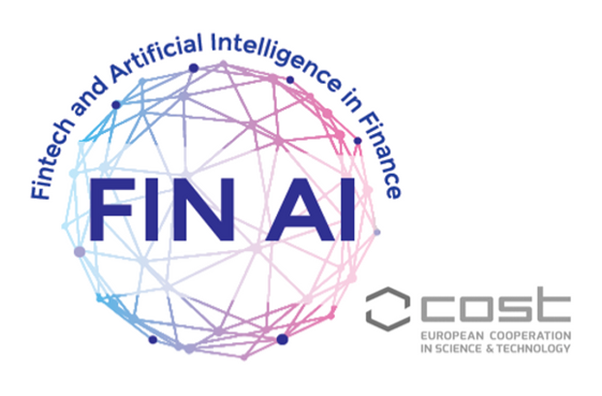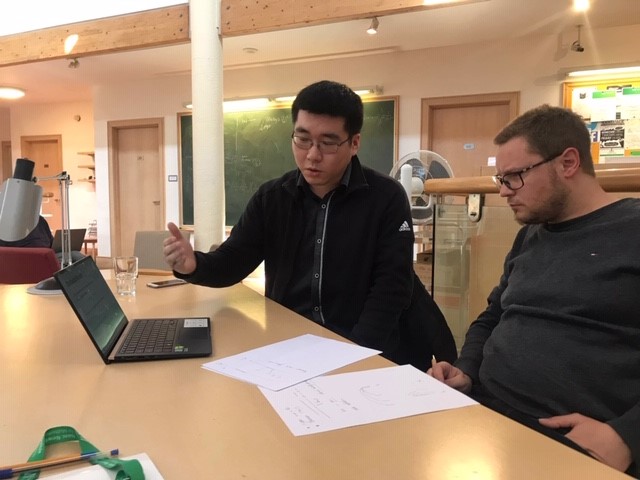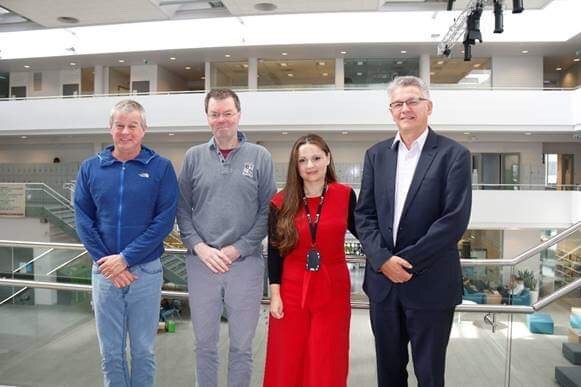Centre for Banking and Finance
Centre for Banking and Finance
What we do
The Centre for Banking and Finance (CeBaF) at NTNU Business School joins the efforts of international researchers who work on a range of topics and activities in finance. CeBaF aims to advance the knowledge and understanding of banking and finance within the context of an evolving national and international landscape, delivering insights to industry professionals and policymakers. In addition to engaging with inspiring researchers, the centre promotes interdisciplinary collaborative research in related fields, connecting researchers with shared research objectives.
How we do it
CeBaF organizes research projects and a variety of initiatives, including workshops, seminars, conferences, and doctoral courses.
Experts at the centre collaborate with national and international partners across four continents in diverse areas of banking and finance. Their research findings are being disseminated in internationally renowned journals and to a wider audience including Norges Bank and several other financial institutions. The centre's research projects have attracted funding from various funding bodies including EU COST ACTIONS and EU Horizon.
Research Fields
Banking
Banking
Some selected ongoing collaborations:
Internal Credit Risk Models – Between Regulatory Intention and End-Effects: Why Do Banks’ Risk Weighted Asset Levels Converge over Time?
Victoria Boehnke, Steven Ongena, Florentina Paraschiv, and Endre J. Reite
The internal ratings-based (IRB) approach maps banks’ distinct risk profiles more adequately than the standardized approach. After the switch to the IRB approach, banks’ risk-weighted asset (RWA) densities are thus expected to diverge, especially across countries with different supervisory strictness and risk levels. However, by examining 52 listed banks headquartered in 14 European countries that adopted the IRB approach, we observe a gradual convergence of their RWA densities over time. Whereas banks in high-risk countries and in countries with lax regulation reduce their RWA densities, banks in countries with strict supervision increase theirs. Furthermore, especially for banks in high-risk countries, the RWA densities underestimate banks’ actual economic risk position. We analyze whether the IRB approach provides opportunities for regulatory arbitrage, whereby authorities only enforce strict supervision on capital requirements if they do not jeopardize bank resilience.
Determinants of Price Discrimination and Switching Mortgage Provider Under Regulation and Digitalization
Steven Ongena, Florentina Paraschiv, Endre J Reite
This study analyzes price discrimination and household switching in the residential mortgage market. Using a unique proprietary micro dataset from Norway, we examine the difference between the loan rate paid by current clients when receiving a competing offer from another bank and the best rate being offered to new customers by the current bank at the same time. The results show that current clients pay around 20 basis points more than new customers are offered; however, this rate differential is kept in check by the existing clients switching or accepting counter-offers from the home bank. New regulations and digitalization enhance transparency; that is, they can reduce the rate differential, but the introduction of new banking products as well as changes in the timing of rate differentiation ̶ from immediate upfront to gradually over time ̶ may be used to keep the differential constant.
Banks and “Green Appearance”
Endre Jo Reite and Florentina Paraschiv
When studying the 2008 financial crisis, one interesting aspect is the ability of banks to bundle and separate tranches of credit risk – seemingly making the risk disappear and selling tranches of high risk loans as low-risk assets. What if what we observe now with the ESG efforts of banks shroud a similar strategy?
As suggested by Benincasa, Kabas, and Ongena (2023), banks continue to provide loans to “brown” industries and to profit from higher margins on such loans due to an increase in the cost of pure market financing to the brown companies through industry bonds. They do this by maintaining an overall “green” appearance of the bank, separating tranches of assets in the bank as “green-bonds”, and marking assets with green labels provided by different consultants. This secures the bank’s access to attractive financing terms and creates a nice little way to profit more as the ESG regulations tighten.
Possible identification strategies:
• Is the credit/financing cost of banks related to the ESG risk in their portfolio?
• Do banks with a larger proportion of brown assets communicate more positive ESG-related news?
• Do banks with a larger proportion of brown assets have lower ESG scores?
Corporate Finance
Corporate Finance
Projects in this field cover a wide range of topics in corporate finance, ranging from corporate funding and investments through to valuation. Focus is also on promoting good governance practices in managing firms’ resources as well as maintaining transparent communication with stakeholders.
- Capital structure: financial and non-financial factors that affect capital structure of firms and their probability of default, and in connection with governmental policies,
- Corporate disclosure: insights on disclosure practices regarding non-financial information such as CSR reporting in light of the changing regulatory framework and their implications for valuation,
- Corporate governance: the influence board structure and attributes as well as the owners have on corporate outcomes and strategies,
- Corporate investments: factors at firm-level and institutional-level that can affect corporate investments,
- Information asymmetry: the implication of information transparency and earnings quality on firm value and investors’ decision making.
Financial Reporting
Financial Reporting
Some selected ongoing collaborations:
Auditor independence in private firms under a voluntary audit regime
Amir Amel-Zadeh, Mahmoud Delshadi, Mahmoud Hosseinniakani, Ranik Raaen Wahlstrøm
Individual auditor traits, audit effort and audit quality
Amir Amel-Zadeh, Mahmoud Delshadi, Mahmoud Hosseinniakani, Ranik Raaen Wahlstrøm
Auditor efforts and cybersecurity
Mahmoud Delshadi, Mahmoud Hosseinniakani, Zabihollah Rezaee, Ranik Raaen Wahlstrøm
Auditor efforts and employee representatives
Mahmoud Hosseinniakani, Mahmoud Delshadi, Niuosha Samani, Ranik Raaen Wahlstrøm
Earnings Conference Calls and Investor Disagreement: The Effect of heterogeneity in participating analysts’ information acquisition focus
Imelda Taraj, Fani Kalogirou, Mari Paananen, Ranik Raaen Wahlstrøm
Narratives contextualizing numeric disclosures: Insights from earnings calls
Imelda Taraj, Ranik Raaen Wahlstrøm
Abnormal disclosure and cost of equity capital: Evidence from textual characteristics of sustainability disclosure
Mahmoud Hosseinniakani, Ishwar Khatri, Per Ståle Knardal, Ranik Raaen Wahlstrøm
En del av analysene omhandler behandling av anonymiserte løpenummer for personnavn. Dette anses som nødvendig for å utføre en oppgave i allmennhetens interesse. Alle rådata fra prosjektet slettes når prosjektet er over, noe som anslås til sent 2025. Personer har en rett til å protestere, å be om innsyn, retting, sletting, begrensning, dataportabilitet, eller klage til Datatilsynet.
Personvernombudet ved NTNU: Thomas Ørnulf Helgesen
Financial Technology (FinTech)
Financial Technology (FinTech)
Financial technology offers exciting new developments to the field of finance. We appreciate the factors that drive the development in FinTech as well as the implications FinTech has on the investment community and the financial system. Some key themes in the FinTech area include:
- Cryptocurrencies: the dynamics of the cryptos and the opportunities they offer, if there is any, to the investors
- Machine learning and explainable artificial intelligence (xAI) for financial analysis and credit risk assessment
Sustainable Finance
Sustainable Finance
Research projects here focus on understanding how businesses and governments facilitate the transition towards a sustainable economy.
- Climate change: capital market in relation to climate risk, and ways in which the capital market, businesses and regulators can accelerate the transition towards addressing climate issues,
- ESG: opportunities and challenges firms face when addressing sustainability issues, actions firms can undertake to mitigate ESG controversies, and the role played by the institutional framework.
- Environmental Innovation: factors that facilitate environmental innovation and the impact government can have on the innovation process.
Some selected ongoing collaborations:
Market coupling – between benefits and losses
Ranik Raaen Wahlstrøm, Michael Schuerle, Dogan Keles, Florentina Paraschiv
Which energy markets benefit from the market coupling? With a focus on the market coupling dynamics at Nord Pool, including Benelux and Germany, we aim at answering questions such as: is the current market coupling model optimal for balancing out renewable energies across involved markets? We consider demand/supply driven variables: production mix in each country, interconnector capacity, trades, CO2 emission certificate prices, gas prices, temperature data in each country to assess the price drivers in each involved country. We further aim at determining benefits and drawbacks of market coupling for different times of the day for the different countries involved.
Fueling the energy transition: The effect of German wind and PV electricity infeed on TTF gas prices
Christoph Halser and Florentina Paraschiv
Gas plants play an essential role in the electricity generation in several fuel-based energy systems through balancing out intermittent renewable energies, which is why it is labeled ”green” in the EU Taxonomy. We show the substitution effect between renewable energies, wind and PV, and gas, in the context of a threshold model. Applied to daily Dutch natural gas prices (TTF) between 2016 and 2020, we determine the effect of demand/supply price drivers and lay special emphasis on the asymmetric effects of the day-ahead forecasts of wind and PV infeed. Results show a negative marginal effect of the day-ahead wind and PV infeed forecasts on day-ahead natural gas prices. Employing threshold models, we find that in regimes with low wind infeed, marginal increases in the wind and PV infeed forecasts decrease gas prices faster than in regimes with high infeed. Our findings further reveal that the day-ahead TTF price is positively associated with heating demand, supplier concentration, coal, and CO2 prices. We discuss these findings in the context of the debate on the usage of gas for the European energy transition.
CET Partnership (co-funded by the European Union) 2023-2026
HyLife – Microbial risks associated with hydrogen underground storage in Europe

EU Grant COST ACTIONS 2020—2025
Fintech and Artificial Intelligence in Finance - Towards a transparent financial industry



